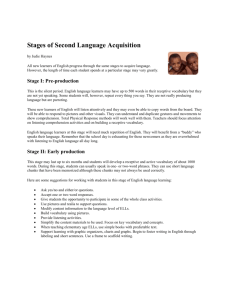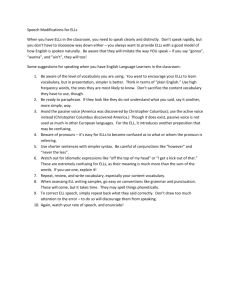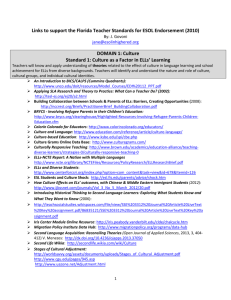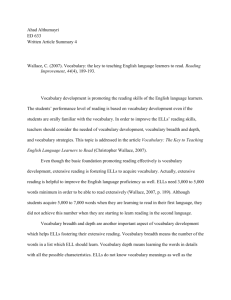Issue 1 | Terms 1 and 2 | March 2009 - NZ Curriculum Online
advertisement
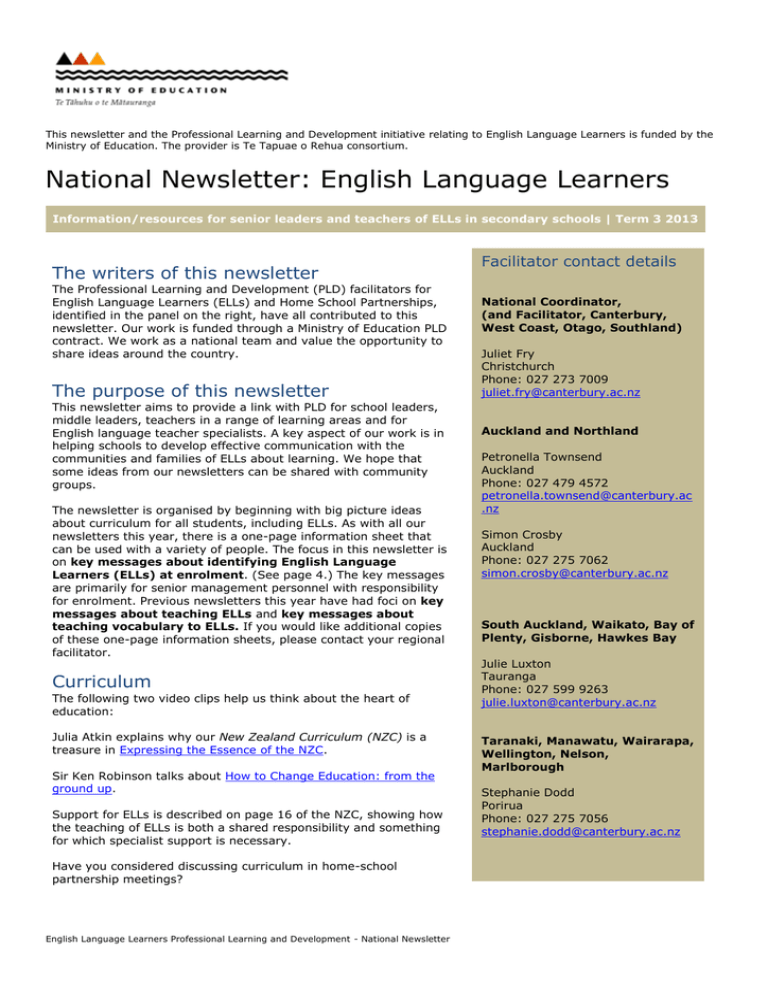
This newsletter and the Professional Learning and Development initiative relating to English Language Learners is funded by the Ministry of Education. The provider is Te Tapuae o Rehua consortium. National Newsletter: English Language Learners Information/resources for senior leaders and teachers of ELLs in secondary schools | Term 3 2013 The writers of this newsletter The Professional Learning and Development (PLD) facilitators for English Language Learners (ELLs) and Home School Partnerships, identified in the panel on the right, have all contributed to this newsletter. Our work is funded through a Ministry of Education PLD contract. We work as a national team and value the opportunity to share ideas around the country. The purpose of this newsletter This newsletter aims to provide a link with PLD for school leaders, middle leaders, teachers in a range of learning areas and for English language teacher specialists. A key aspect of our work is in helping schools to develop effective communication with the communities and families of ELLs about learning. We hope that some ideas from our newsletters can be shared with community groups. The newsletter is organised by beginning with big picture ideas about curriculum for all students, including ELLs. As with all our newsletters this year, there is a one-page information sheet that can be used with a variety of people. The focus in this newsletter is on key messages about identifying English Language Learners (ELLs) at enrolment. (See page 4.) The key messages are primarily for senior management personnel with responsibility for enrolment. Previous newsletters this year have had foci on key messages about teaching ELLs and key messages about teaching vocabulary to ELLs. If you would like additional copies of these one-page information sheets, please contact your regional facilitator. Curriculum The following two video clips help us think about the heart of education: Julia Atkin explains why our New Zealand Curriculum (NZC) is a treasure in Expressing the Essence of the NZC. Sir Ken Robinson talks about How to Change Education: from the ground up. Support for ELLs is described on page 16 of the NZC, showing how the teaching of ELLs is both a shared responsibility and something for which specialist support is necessary. Have you considered discussing curriculum in home-school partnership meetings? English Language Learners Professional Learning and Development - National Newsletter Facilitator contact details National Coordinator, (and Facilitator, Canterbury, West Coast, Otago, Southland) Juliet Fry Christchurch Phone: 027 273 7009 juliet.fry@canterbury.ac.nz Auckland and Northland Petronella Townsend Auckland Phone: 027 479 4572 petronella.townsend@canterbury.ac .nz Simon Crosby Auckland Phone: 027 275 7062 simon.crosby@canterbury.ac.nz South Auckland, Waikato, Bay of Plenty, Gisborne, Hawkes Bay Julie Luxton Tauranga Phone: 027 599 9263 julie.luxton@canterbury.ac.nz Taranaki, Manawatu, Wairarapa, Wellington, Nelson, Marlborough Stephanie Dodd Porirua Phone: 027 275 7056 stephanie.dodd@canterbury.ac.nz Success for bilingual and multilingual Pasifika ELLs “Pasifika success will be characterized by demanding, vibrant, dynamic, successful Pasifika learners, secure and confident in their identities, languages and cultures, navigating through all curriculum areas.” Pasifika Education Plan 2013-2017 Targets from the Pasifika Education Plan include: The number of all Pasifika school leavers leaving with NCEA Level 1 literacy and numeracy qualifications to increase from 80% in 2010 to 95% in 2017. 85% of Pasifika 18 year olds to achieve NCEA Level 2 or equivalent in 2017. In the article by Karlo Mila-Schaaf and Elizabeth Robinson ‘Polycultural’ capital and educational achievement among NZ-born Pacific peoples, maintenance of Pacific values, cultural pride, Pacific language fluency and acceptance from Pacific peoples and others were all significantly associated with positive educational outcomes: trying hard at school, doing well at school and making plans for the future. ‘Polycultural’ capital is associated with cross-cultural resources, knowledge, skills and agency – students being able to draw purposefully and strategically from more than one cultural way of knowing and interpreting the world. In the light of the findings of Mila-Schaaf and Robinson, the following statistics might be of use in helping schools to consider whether the range of standards used to assess bilingual Pasifika students’ language might be extended. How could your school provide support for Pasifika students to achieve in their home languages? NZQA subject Pacific Studies (unit standards) Lea Faka-Tonga (unit standards) Vagahau Niue (unit standards) Samoan (unit and achievement standards) Cook Is Māori (unit and achievement standards) ESOL (unit standards) Number of results for Pasifika peoples in 2012 548 359 514 5304 1163 2750 Given that there are 11,135 ESOL results for Asian students, we need to question whether our school systems are disadvantaging Pasifika students. How can our systems change to enable more Pasifika ELLs to access NCEA success through ESOL standards? To provide an opportunity to demonstrate Pasifika students’ skills, is it possible to weave a Pacific Studies standard into some ESOL class learning? Could the Pacific Studies standards work in different learning areas like Technology? Would it be useful to look at the new English for Academic Purposes standards for Pasifika students and other ELLs heading for tertiary education? The Public Achievement Information, the PAI Pipeline on Education Counts, is a new site from the Ministry of Education that provides key statistics at a national and regional level, disaggregating NCEA data by ethnicity and reminding us of these disparities. As we work to reach the targets outlined in the Pasifika Education Plan, these statistics may help us to think about changes to our schools to enable Pasifika students access language standards. English Language Learners Professional Learning and Development - National Newsletter ESOL Online The ELLs PLD facilitators wish to acknowledge Breda Matthews for her facilitation of the ESOL Online community. Breda has done a wonderful job of keeping us all informed and talking about matters that matter in relation to ELLs. We have been most fortunate in having such a vibrant online community. The contract for this work has been moved from Cognition Education to CORE Education. Those of you who participate in the community will have received information about the transitional arrangements through your emails. EL standards ESOL standards are being changed to English Language (EL) standards. They remain as standards for ELLs but the term is a bit more inclusive. In this newsletter, both terms are used. The link to the NZQA EL site is: http://www.nzqa.govt.nz/qualificati onsstandards/qualifications/englishlanguage-qualifications/review/ By the time you receive this newsletter the latest information is likely to be available. Māori students transitioning from kura kaupapa Have you considered using the EL standards with Māori students transitioning from kura kaupapa? There are 37 ESOL results for Māori students in 2012. With good support, anyone literate in one language can be expected to access English as an additional language at an accelerated rate. These standards might be useful in acknowledging such Māori students’ developing academic fluency. 2 English for Academic Purposes (EAP) unit standards English for Academic Purposes (EAP) Unit Standards are a set of five standards designed to assess a learner’s readiness for tertiary study at undergraduate level. They are particularly suited to the needs of English Language Learners (ELLs) as they offer a literacy pathway that is research based with a stated academic purpose, rather than the generally more literary study offered through the subject of English. In this respect they are more in line with a cycle of study that students often encounter at university. The standards have been developed in response to university and student needs. In several interviews with English language learners conducted by Simon Crosby, an Auckland ELLs PLD facilitator, the first year university students said that schools had not fully prepared them for their studies. “We get a maximum of 2 weeks and assignments of over 1,000 words,’ said one student. “I was shocked - it wasn’t easy to manage. It wasn’t about grammar. You had to read a lot and understand and analyse. The analysing part was challenging.” A further study is planned to interview students who used/are using the EAP pathway to gain university entrance in 2014. PLD for EAP standards This year, ELL facilitators have been working with teachers to network, develop resources and provide help and guidance. A Virtual Learning Network (VLN) group has been set up to enable the sharing of EAP resources and discussion of EAPrelated issues nationwide. This now has 52 members. A session is being run this month by Jenni Bedford and Breda Matthews in Auckland to help gather material for some online resources that will become available once they are complete. This workshop is a oneoff. However, the ELLs PLD facilitators will be working with NZQA and the developers of the online resources to ensure that teachers have more support for using the EAP standards by next year. NZQA is underway in producing a newsletter on the EAP standards. Crafting an integrated cycle of study Academic listening e.g. note taking, inferring, synthesising ideas from presentations, thinking critically, summarising. US 22892 Listening Academic reading e.g. identifying purpose for reading, skimming for information, organising ideas, inferring, reading critically, drawing conclusions. US 22751 Reading (UE Lit) Presenting academic ideas orally e.g. presenting broad knowledge and theory of subject matter which is clear and appropriate to an audience. US 22981 Speaking Academic writing e.g. managing a research process, developing ideas and displaying knowledge, structuring text using academic tone, language forms, vocabulary, acknowledging sources appropriately. US 22750 Crafted writing (UE Lit) e.g. organising ideas under pressure, express academic ideas using precise language under test conditions. US 22749 Writing under test conditions English Language Learners Professional Learning and Development - National Newsletter National newsletters National newsletters are developed for every learning area by National Co-ordinators from The University of Auckland and/or Te Tapuae o Rehua consortium (University of Canterbury, University of Otago and Te Runanga o Ngāi Tahu). This term, the ELLs newsletter is distributed under the same system. To download the latest newsletter or for more information about Ministry-funded professional development for secondary middle leaders, visit this page on TKI: http://nzcurriculum.tki.org.nz/Seco ndary-middle-leaders/Professionallearning-and-development 3 Key messages to help identify English language learners (ELLs) at enrolment MOE priorities Priority 1 in the Ministry of Education's Statement of Intent is to improve education outcomes for Māori learners, Pasifika learners, learners with special education needs, and learners from low socioeconomic backgrounds. Students who are English language learners - ELLs - are represented in all of these learner groups. Gathering information about ELLs The New Zealand Curriculum makes it clear that schools are required to “gather information that is sufficiently comprehensive to enable evaluation of student progress and achievement; to identify students and groups of students … who are at risk of not achieving” (page 44). The ELLs group is diverse and includes students from overseas and New Zealand born students. To assist in accurately identifying English language learners’ language strengths and needs, the following approaches are recommended. These may be included in your policy. Appropriate staff, who understand and have familiarity with the processes involved in learning an additional language, should attend the enrolment meeting. This is generally the teacher in charge of ELLs. A trained interpreter is employed when required, to ensure all relevant information is able to be given to, and received by, the student and their family. Possible contacts for these services include: http://www.interpret.org.nz and http://ethnicaffairs.govt.nz/browse/language-line. Accurately assessing the English language proficiency of a new student will require appropriate assessments by a trained ELLs specialist teacher. This needs to happen before final class placement and timetable decisions are made. However, changes may be needed as a student’s learning develops and his/her strengths and needs are monitored. It is important to establish proficiency levels in first language/s to establish bi- and multi-lingual strengths. With whānau/family, establish other learning strengths and needs especially as some learners will need multiple levels of support. Secondary students at ELLP Stage 2 or below will need intensive specialist language support to access the curriculum at age-appropriate levels. Students at ELLP Stage 3 will be able to access the curriculum more easily with scaffolded support. Funding for this support will come primarily from the school’s operations grant and may be supplemented by MOE ESOL funding and money from international fee-payers. English Language Learners Professional Learning and Development - National Newsletter How you might miss ELLs An English language learner’s needs may be missed at enrolment for a variety of reasons. Students learn social English more quickly than academic English (Cummins 2002). It is easy to overlook the academic language learning needs of ELLs who are reasonably competent with social English. It is good practice to have an enrolment, assessment and placement policy for ELLs. Who you might miss There are various groups of students whose needs may not be accurately identified. There will not be a one-size-fits–all response: There are students transitioning from kura kaupapa. Family reunification refugees and asylum seekers generally would not have had the initial support available at the Mangere Resettlement Centre. They might need particular support. Students transitioning from Year 8 to Year 9, especially Pasifika students, need to be understood well. Close liaison with the contributing school and family is important. Often ELLs are assessed in one-off written tests and their bilingual strengths and progress are not understood. Placing students Too many emerging bilingual students are wrongly placed in lowband classes at Year 9. ELLs should be given challenge and high support and are generally better placed in high band classes. G ELLs should be placed with their age-group. Finding out more Comprehensive information about good practices for enrolment and placement may be found in the MOE Refugee Handbook. These processes and practices would also benefit other English language learners. http://www.minedu.govt.nz/NZEduc ation/EducationPolicies/Schools/Eng lishForSpeakersOfOtherLanguages/ MaterialsResources/ESOLRefugeeHa ndbook.aspx and http://esolonline.tki.org.nz/ESOLOnline/Student-needs/EnglishLanguage-Learning-Progressions. 4

